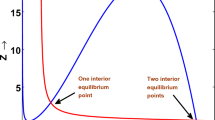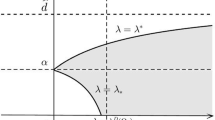Abstract
We give a stochastic foundation to the Volterra prey-predator population in the following case. We take Volterra's predator equations and let a free host birth and death process support the evolution of the predator population. The purpose of this article is to present a rigorous population sample path construction of this interacted predator process and study the properties of this interacted process. The constructions yields a strong Markov process. The existence of steady-state distribution for the interacted predator process means the existence of equilibrium population level. We find a necessary and sufficient condition for the existence of a steady-state distribution. Next we see that if the host process possesses a steady-state distribution, so does the interacted predator process and this distribution satisfies a difference equation. For special choices of the auto death and interaction parametersa andb of the predator, whenever the host process visits the particular statea *=a/b the predator takes rest (saturates) from its evolution. We find the probability of asymptotic saturating of the predator.
Similar content being viewed by others
Literature
Becker, N. G. 1975. “A stochastic model for two interacting populations.”J. Appl. Prob. 7, 544–564.
Bharucha-Reid, A. T. 1960.Elements of the Theory of Markov Processes and Their Applications. New York: McGraw-Hill.
Blumenthal, R. M. and R. K. Getoor. 1968.Markov Processes and potential Theory. New York: Academic Press.
Doob, J. L. 1953.Stochastic Processes. New York: Wiley.
Dynkin, E. B. 1965.Markov Processes. Vol. I. New York: Springer-Verlag.
Feller, W. 1966.An Introduction to Probability Theory and its Applications, Vol. II. New York: Wiley.
Gard, T. C. and D. Kannan. 1976. “On a stochastic differential equation modeling of prey-predator evolution”J. Appl. Prob.,13.
Goel, N. S., S. C. Maitra and E. W. Montroll. 1971. “On the Volterra and other non-linear models of interacting populations.”Rev. Mod. Phys.,43, 231–276.
Hille, E. 1969.Lectures in Ordinary Differential Equations. Massachusetts: Addison-Wesley.
Moyal, J. E. 1957. “Discontinous Markoff Processes.”Acta Math.,98, 221–264.
Neveu, J. 1965.Mathematical Foundations of the Calculus of Probability. San Francisco: Holden-Day.
Puri, P. S. 1975. “A linear birth and death process under the influence of another process.”J. Appl. Prob.,12, 1–17.
Rescigno, A. and I. W. Richardson. 1973. “The deterministic theory of population dynamics.” InFoundations of Mathematical Biology, Vol. III, ed. R. Rosen, New York: Academic Press.
Watanabe, T. 1968. “Approximation of uniform transport process on a find interval to Brownian motion.”Nagoya Math. J.,32, 297–314.
Author information
Authors and Affiliations
Rights and permissions
About this article
Cite this article
Kannan, D. On some Markov models of certain interacting populations. Bltn Mathcal Biology 38, 723–738 (1976). https://doi.org/10.1007/BF02458646
Received:
Revised:
Issue Date:
DOI: https://doi.org/10.1007/BF02458646




